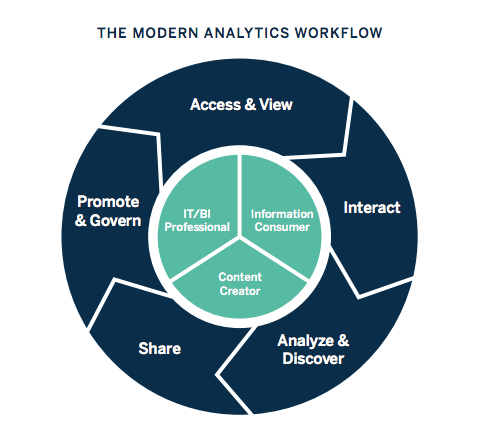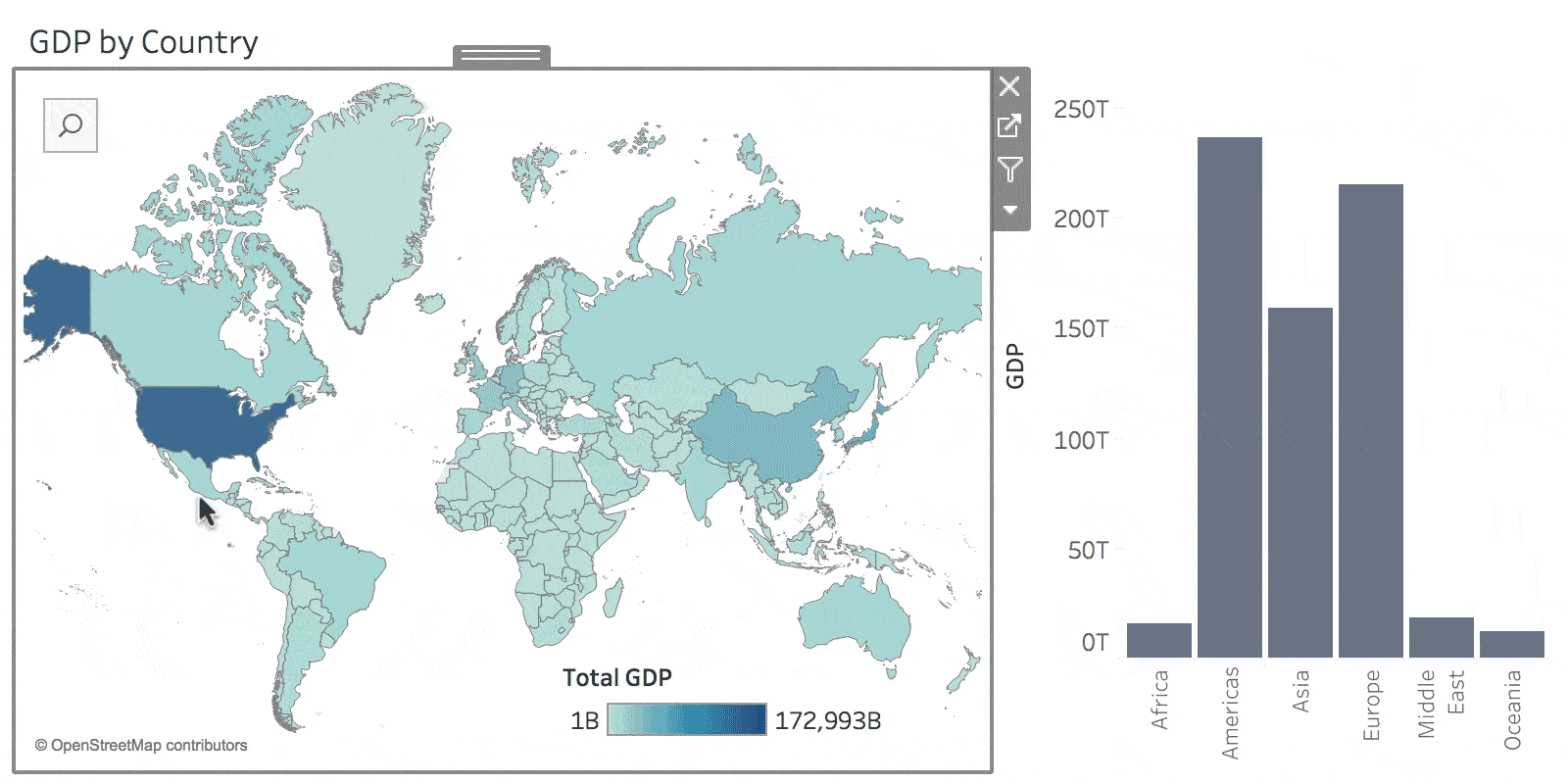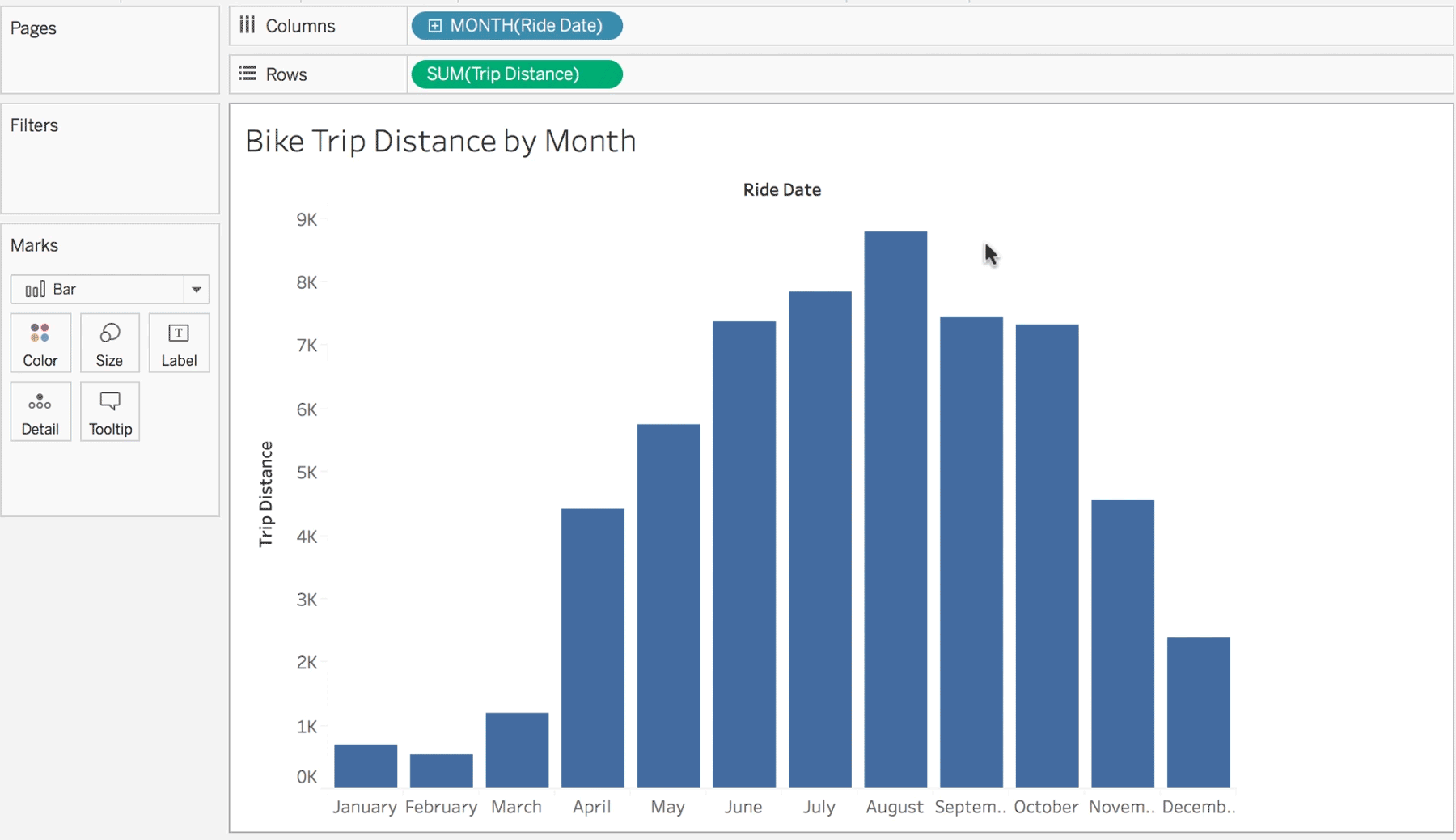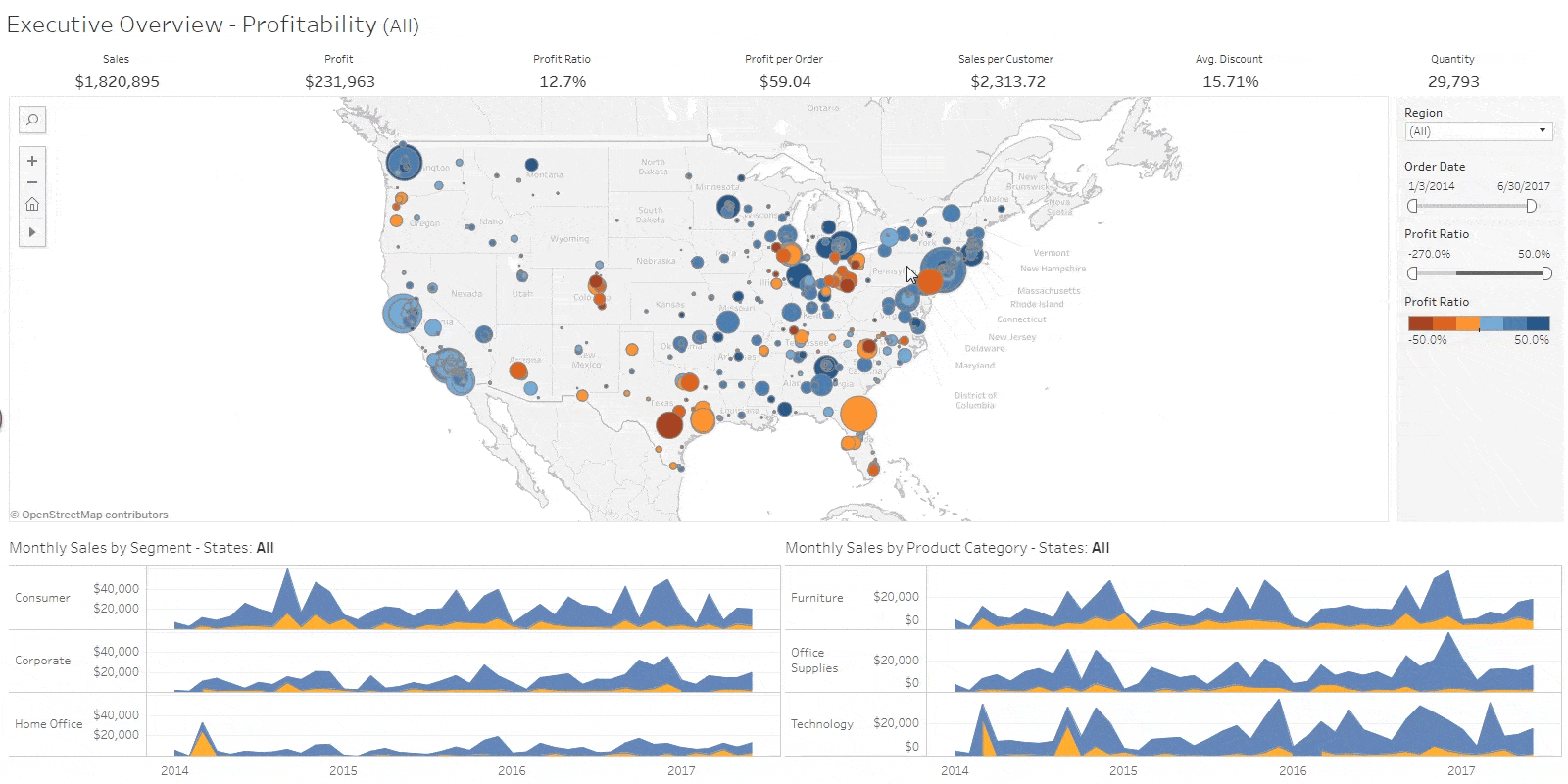Business intelligence: A complete overview
Try Tableau for FreeWhat is business intelligence?
Business intelligence combines business analytics, data mining, data visualization, data tools and infrastructure, and best practices to help organizations make more data-driven decisions. In practice, you know you’ve got modern business intelligence when you have a comprehensive view of your organization’s data and use that data to drive change, eliminate inefficiencies, and quickly adapt to market or supply changes. Modern BI solutions prioritize flexible self-service analysis, governed data on trusted platforms, empowered business users, and speed to insight.
It’s important to note that this is a very modern definition of BI—and BI has had a strangled history as a buzzword. Traditional Business Intelligence, capital letters and all, originally emerged in the 1960s as a system of sharing information across organizations. The term Business Intelligence was coined in 1989, alongside computer models for decision making. These programs developed further, turning data into insights before becoming a specific offering from BI teams with IT-reliant service solutions. This article will serve as an introduction to BI and is the tip of the iceberg.
In this article, we cover:
How does business intelligence work?

Businesses and organizations have questions and goals. To answer these questions and track performance against these goals, they gather the necessary data, analyze it, and determine which actions to take to reach their goals.
On the technical side, raw data is collected from business systems. Data is processed and then stored in data warehouses, the cloud, applications, and files. Once it’s stored, users can access the data, starting the analysis process to answer business questions.
BI platforms also offer data visualization tools, which convert data into charts or graphs, as well as presenting to any key stakeholders or decision-makers.
BI processes
Much more than a specific “thing,” business intelligence is an umbrella term that covers the processes and methods of collecting, storing, and analyzing data from business operations or activities to optimize performance. All of these things come together to create a comprehensive view of a business to help people make better, actionable decisions. Over the past few years, business intelligence has evolved to include more processes and activities to help improve performance. These processes include:
- Data mining: Using databases, statistics, and machine learning (ML) to uncover trends in large datasets
- Reporting: Sharing data analysis to stakeholders so they can draw conclusions and make decisions
- Performance metrics and benchmarking: Comparing current performance data to historical data to track performance against goals, typically using customized dashboards
- Descriptive analytics: Using preliminary data analysis to find out what happened
- Querying: Asking the data-specific questions, BI pulling the answers from the data sets
- Statistical analysis: Taking the results from descriptive analytics and further exploring the data using statistics such as how this trend happened and why
- Data visualization: Turning data analysis into visual representations such as charts, graphs, and histograms to more easily consume data
- Visual analysis: Exploring data through visual storytelling to communicate insights on the fly and stay in the flow of analysis
- Data preparation: Compiling multiple data sources, identifying the dimensions and measurements, and preparing it for data analysis
How BI, data analytics, and business analytics work together
Business intelligence includes data analytics and business analytics but uses them only as parts of the whole process. BI helps users draw conclusions from data analysis. Data scientists dig into the specifics of data, using advanced statistics and predictive analytics to discover patterns and forecast future patterns.
Data analytics asks, “Why did this happen and what can happen next?” Business intelligence takes those models and algorithms and breaks the results down into actionable language. According to Gartner's IT glossary, “business analytics includes data mining, predictive analytics, applied analytics, and statistics.” In short, organizations conduct business analytics as part of their larger business intelligence strategy.
BI is designed to answer specific queries and provide at-a-glance analysis for decisions or planning. However, companies can use the processes of analytics to continually improve follow-up questions and iteration. Business analytics shouldn’t be a linear process because answering one question will likely lead to follow-up questions and iteration. Rather, think of the process as a cycle of data access, discovery, exploration, and information sharing. This is called the cycle of analytics, a modern term explaining how businesses use analytics to react to changing questions and expectations.
The difference between traditional BI and modern BI

Modern BI prioritizes self-service analytics and speed to insight.
Historically, business intelligence tools were based on a traditional business intelligence model. This was a top-down approach where business intelligence was driven by the IT organization and most, if not all, analytics questions were answered through static reports. This meant that if someone had a follow-up question about the report they received, their request would go to the bottom of the reporting queue and they would have to start the process over again. This led to slow, frustrating reporting cycles, and people weren’t able to leverage current data to make decisions.
Traditional business intelligence is still a common approach for regular reporting and answering static queries. However, modern business intelligence is interactive and approachable. While IT departments are still an important part of managing access to data, multiple levels of users can customize dashboards and create reports on little notice. With the proper software, users are empowered to visualize data and answer their own questions.
Benefits of business intelligence

Great BI helps businesses and organizations ask and answer questions of their data.
So now you know what business intelligence is, and how it works. But how does it actually help businesses?
BI is more than just software—it’s a way to keep a holistic and real-time view of all your relevant business data. Implementing BI offers a myriad of benefits, from better analysis to an increase in competitive advantage. Some of the top business intelligence benefits include:
- Data clarity
- Increased efficiency
- Better customer experience
- Improved employee satisfaction
Business intelligence examples
Tableau's Explain Data feature helps to quickly identify possible explanations of outliers and trends in data.
Many disparate industries have adopted enterprise BI ahead of the curve, including healthcare, information technology, and education. All organizations can use data to transform operations. With as much information as is in this article and available online, it can be difficult to understand the exact capabilities of BI. Real-world examples can help, which is why we build case studies out of our clients’ success stories.
For example, financial services firm Charles Schwab used business intelligence to see a comprehensive view of all its branches across the United States to understand performance metrics and identify areas of opportunity. Access to a central business intelligence platform allowed Schwab to bring its branch data into one view. Now branch managers can identify clients that may have a change in investment needs. And leadership can track if a region's performance is above or below average and click in to see the branches that are driving that region's performance. This leads to more opportunities for optimization along with better customer service for clients.
Another example is the meal-kit service HelloFresh which automated its reporting processes because its digital marketing team spent far too much time on it each month. With the help of Tableau, HelloFresh saved 10 to 20 working hours per day for the team, and made it possible for them to create much more segmented and targeted marketing campaigns.
How to create a business intelligence strategy
A BI strategy is your blueprint for success. You’ll need to decide how data is used, gather key roles, and define responsibilities in the initial phases. It may sound simple at a high level; however, starting with business goals is your key to success.
Here’s how to create a BI strategy from the ground up:
- Know your business strategy and goals.
- Identify key stakeholders.
- Choose a sponsor from your key stakeholders.
- Choose your BI platform and tools.
- Create a BI team.
- Define your scope.
- Prepare your data infrastructure.
- Define your goals and roadmap.
Read more about our complete roadmap to developing a successful BI strategy.
Categories of BI analysis
There are three major types of BI analysis, which cover many different needs and uses. These are predictive analytics, descriptive analytics, and prescriptive analytics.
- Predictive analytics takes historical and real-time data and models future outcomes for planning purposes.
- Descriptive analytics is the process of identifying trends and relationships in data using historical and current data.
- Prescriptive analytics takes all the relevant data to answer the question, “what should my business do?”
Advantages and disadvantages of BI
We’ve covered a lot of the pros of BI. But as with any major business decision, implementing BI comes with some difficulties and disadvantages, particularly in the implementation stage.
Some of the advantages of BI include:
- Data visibility
- Accurate reports
- Streamlined processes
And disadvantages of BI include:
- Initial cost
- User resistance
- Data skills gap
Business intelligence platforms

Visual analytics keeps you in the flow of data analysis.
Many self-service business intelligence tools and platforms streamline the analysis process. This makes it easier for people to see and understand their data without the technical know-how to dig into the data themselves. There are many BI platforms available for ad hoc reporting, data visualization, and creating customized dashboards for multiple levels of users. We have outlined our recommendations for evaluating modern BI platforms so you can choose the right one for your organization. One of the more common ways to present business intelligence is through data visualization.
How to choose a BI platform
The key to successfully implementing BI is to choose the right platform for the job. In choosing your tool, it’s best to keep in mind what key features will be most helpful for your business. Some key features of BI tools include:
- Intuitive to use
- Variety of dashboard and visualization options
- Smart insights
- Alerts for good and bad metrics
- Built-in artificial intelligence (AI)
- Deployment flexibility
- Integration with other platforms and applications
- Data connectivity
- Embedding in business applications
Learn more about how to choose a BI platform for your business.
BI dashboard
Arguably one of the most useful tools in BI are dashboards, which allow complex data to be aggregated and viewed all in one place. These dashboards can have different purposes, such as for complex analysis or stakeholder buy-in. The challenge is building the best dashboard for your needs.
The key features of a BI dashboard are:
- Interactivity
- Real-time data
- Customizable interface
- Standard templates
- Sharing ability
Learn more about BI dashboards, including best practices and benefits.
BI and big data
As the data atmosphere grows and the gathering, storage, and analysis of data becomes more complex, it’s important to consider the relationship between BI and big data. Big data has become a bit of a buzzword in the industry lately, so what exactly is it? Well, data experts define it by “the four Vs”: Volume, velocity, value, and variety. These four define big data and set it apart. In particular, volume is what people normally point to as the main defining factor, as the amount of data is ever-increasing and relatively easy to store for long periods of time.
As you can imagine, this is important for BI as businesses create more and more data by the year, and BI platforms have to keep up with the increasing demands made on them. A good platform will grow with increasing demands. But if not maintained, dashboards and data sources may fall behind as big data evolves.
The future role of business intelligence
Business intelligence is continually evolving to keep pace with business needs and technology, so each year, we identify current trends to keep users up-to-date on innovations. Realize that artificial intelligence and machine learning will continue to grow, and businesses can integrate the insights from AI into a broader BI strategy. As companies strive to be more data-driven, efforts to share data and collaborate will increase. Data visualization will be even more essential to work together across teams and departments. This article is just an introduction to the world of business intelligence. BI offers capabilities for near real-time sales tracking, allowing users to discover insights into customer behavior, forecast profits, and more. Diverse industries like retail, insurance, and oil have adopted BI, and more are joining each year. BI platforms adapt to new technology and the innovation of its users.
Using self-service business intelligence (SSBI) for your company
Today, more organizations are moving to a modern business intelligence model, characterized by a self-service approach to data. Self-service business intelligence (SSBI) is characterized by IT managing the data (security, accuracy, and access), allowing users to interact with their data directly. Modern analytics platforms like Tableau help organizations address every step in the cycle of analytics—data preparation in Tableau Prep, analysis and discovery in Tableau Desktop, and sharing and governance in Tableau Server or Tableau Cloud. This means that IT can govern data access while empowering more people to visually explore their data and share their insights.
Business Intelligence FAQs
How can BI help my business?
Business intelligence helps businesses gain a competitive edge by transforming raw data into actionable insights. It improves decision-making, identifies market trends, increases operational efficiency, and helps you understand customer behavior.
What is the difference between a BI dashboard and a report?
A business intelligence dashboard provides a quick, high-level overview of key metrics, often in real-time, using charts and graphs. A report is typically a static document that provides detailed, in-depth analysis on a specific topic.
How is BI different from business analytics?
Business intelligence primarily focuses on descriptive analysis, which answers the question "what happened?" Business analytics is a broader field that includes BI but also uses predictive and prescriptive analysis to answer "what will happen?" and "what should we do?"
What are the key components of a business intelligence system?
A typical BI system includes three main parts: data integration, which gathers data from various sources; a data warehouse, which stores the integrated data; and a reporting and visualization layer, which presents the insights in an understandable format like dashboards and charts.
Is business intelligence only for large companies?
No, business intelligence is scalable for businesses of all sizes. Small and medium-sized businesses can use accessible BI platforms to analyze their customer data, manage inventory, and optimize marketing strategies without a large investment in infrastructure.
How does BI help with customer experience?
BI tools help analyze customer data from various touchpoints to reveal preferences, behaviors, and pain points. This insight allows companies to create more personalized experiences, improve customer service, and increase loyalty and retention.
What is data governance in business intelligence?
Data governance is a set of policies and procedures that ensure the quality, security, and integrity of a company's data. It is critical for business intelligence to ensure that all users are working with accurate, consistent, and trusted information for analysis and decision-making.
Learn more about BI
Though this article covered a lot of ground about business intelligence and its various applications, there is much more to learn. Our experts are always expanding their knowledge and keeping up with current trends.
To encourage data learning, we’ve compiled lists of further learning resources. If you want to dive deeper into the theory and history of BI, check out our list of the best BI books out there. To keep up with the latest news and insights, take a look at our list of the best BI blogs to follow.

